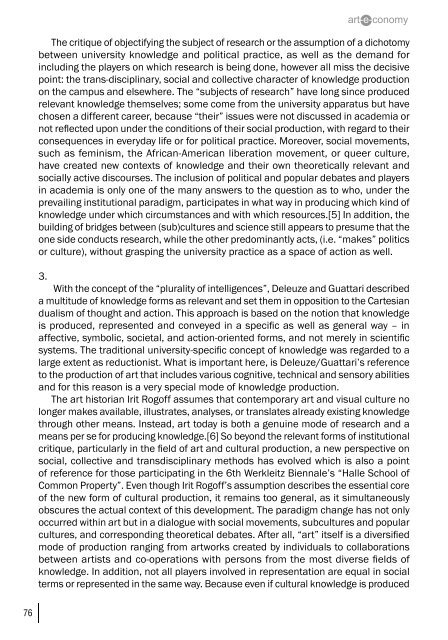art-e-conomy _ reader - marko stamenkovic
art-e-conomy _ reader - marko stamenkovic
art-e-conomy _ reader - marko stamenkovic
You also want an ePaper? Increase the reach of your titles
YUMPU automatically turns print PDFs into web optimized ePapers that Google loves.
76<br />
The critique of objectifying the subject of research or the assumption of a dichotomy<br />
between university knowledge and political practice, as well as the demand for<br />
including the players on which research is being done, however all miss the decisive<br />
point: the trans-disciplinary, social and collective character of knowledge production<br />
on the campus and elsewhere. The “subjects of research” have long since produced<br />
relevant knowledge themselves; some come from the university apparatus but have<br />
chosen a different career, because “their” issues were not discussed in academia or<br />
not reflected upon under the conditions of their social production, with regard to their<br />
consequences in everyday life or for political practice. Moreover, social movements,<br />
such as feminism, the African-American liberation movement, or queer culture,<br />
have created new contexts of knowledge and their own theoretically relevant and<br />
socially active discourses. The inclusion of political and popular debates and players<br />
in academia is only one of the many answers to the question as to who, under the<br />
prevailing institutional paradigm, p<strong>art</strong>icipates in what way in producing which kind of<br />
knowledge under which circumstances and with which resources.[5] In addition, the<br />
building of bridges between (sub)cultures and science still appears to presume that the<br />
one side conducts research, while the other predominantly acts, (i.e. “makes” politics<br />
or culture), without grasping the university practice as a space of action as well.<br />
3.<br />
With the concept of the “plurality of intelligences”, Deleuze and Guattari described<br />
a multitude of knowledge forms as relevant and set them in opposition to the C<strong>art</strong>esian<br />
dualism of thought and action. This approach is based on the notion that knowledge<br />
is produced, represented and conveyed in a specific as well as general way – in<br />
affective, symbolic, societal, and action-oriented forms, and not merely in scientific<br />
systems. The traditional university-specific concept of knowledge was regarded to a<br />
large extent as reductionist. What is important here, is Deleuze/Guattari’s reference<br />
to the production of <strong>art</strong> that includes various cognitive, technical and sensory abilities<br />
and for this reason is a very special mode of knowledge production.<br />
The <strong>art</strong> historian Irit Rogoff assumes that contemporary <strong>art</strong> and visual culture no<br />
longer makes available, illustrates, analyses, or translates already existing knowledge<br />
through other means. Instead, <strong>art</strong> today is both a genuine mode of research and a<br />
means per se for producing knowledge.[6] So beyond the relevant forms of institutional<br />
critique, p<strong>art</strong>icularly in the field of <strong>art</strong> and cultural production, a new perspective on<br />
social, collective and transdisciplinary methods has evolved which is also a point<br />
of reference for those p<strong>art</strong>icipating in the 6th Werkleitz Biennale’s “Halle School of<br />
Common Property”. Even though Irit Rogoff’s assumption describes the essential core<br />
of the new form of cultural production, it remains too general, as it simultaneously<br />
obscures the actual context of this development. The paradigm change has not only<br />
occurred within <strong>art</strong> but in a dialogue with social movements, subcultures and popular<br />
cultures, and corresponding theoretical debates. After all, “<strong>art</strong>” itself is a diversified<br />
mode of production ranging from <strong>art</strong>works created by individuals to collaborations<br />
between <strong>art</strong>ists and co-operations with persons from the most diverse fields of<br />
knowledge. In addition, not all players involved in representation are equal in social<br />
terms or represented in the same way. Because even if cultural knowledge is produced


